Best 4-Channel Car Amplifiers
With many high quality amplifiers on the market, it’s not easy knowing which is the best 4-channel amp and getting the right one can be a daunting process if you don’t know what to look out for.
Unless you buy a high-end vehicle, you will need one to power your tunes, because factory stereo systems are subpar. Therefore, an investment in a good quality amplifier will improve your car stereo sound system no end, even if you don’t add any other parts. So if you really want to pump those tunes, a good quality car amplifier should be the first thing you look to upgrade.
But what is the best 4-channel amp? As with everything in the car audio industry, there’s no single best 4-channel amplifier, and much of it boils down to your taste and your existing stereo system.
In this review, I have put together a list of some of the best 4-channel amplifiers on the market, whatever the vehicle. There are many others and I have tried to be as diverse as possible, and ensure there’s an amp for all needs and costs.
After the review there’s an in-depth Car Amp Buyer’s Guide to help make sure you understand exactly the best amplifier to get for you.
What Is The Best 4-Channel Amp?
Alpine X-A70F X-Series – 4-Channel Amp
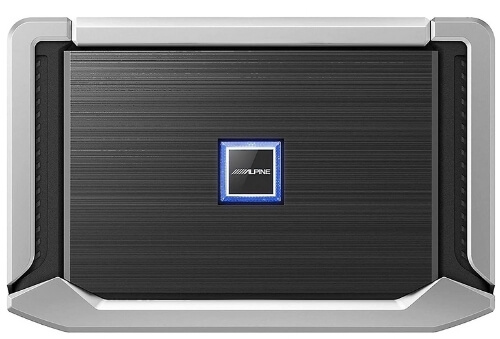
The first product on my list is from Alpine, the only brand to get two picks – a brand that has been making high quality car audio equipment for decades.
This Alpine Amp X-A70F is quite simply the best 4-channel amplifier for overall sound quality and performance, not only on my list, but in the car audio space.
In fact, it’s actually a better amp for many of my chosen niches than other amps take the title for, but it comes at a cost. This amplifier is very expensive, and possibly out of most people’s price range.
The amp pushes 120 watts of RMS power per channel @ 4 ohms impedance, making it the most powerful amp on my list. But of course, the power isn’t limited. If you want more power you can push 175W RMS @ 2 ohms.
This will allow you to run 4 high performance speakers around your vehicle, and the soundscape will likely be better than anything you have ever heard in a car.
If for some reason you want even more power, this amplifier is bridgeable, and will allow you to run a 3-channel or 2-channel amplifier. An example set up will give you 350W RMS x 2 @ 4 ohms for some of the most incredible volume. Too much, in fact, but some people like their car to really shake.
All that power you might think the amp will overheat, but thanks to its D Class, and the heatsink design, the amp performs well for long periods of time without getting too hot.
It’s not just the power, either. this amp has the broadest frequency range at 5 Hz to 100 kHz frequency range. No other amp on the list comes anywhere near that value, and this allows for some amazing fidelity.
The Alpine X-A70F also has the least amount of S/N at 115/95 dB and the THD is a low 0.05%, both of which makes this amp’s dynamic, realistic sound reproduction second-to-none.
I haven’t even mentioned the controls on this, but I want to give each amplifier an equal footing. All I will say is that you get everything you pay for, but that is its only let down: This Alpine amp very expensive.
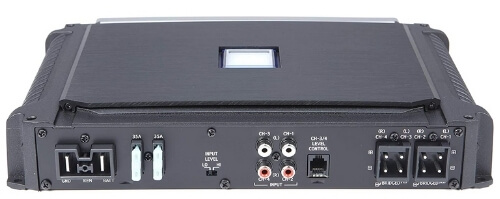
- Easily adjustable settings
- Zero distortion
- Very powerful
- Pristine clarity
- Very expensive
- Bulky
Rockford Fosgate P600X4 Punch – 4 Channel Amplifier
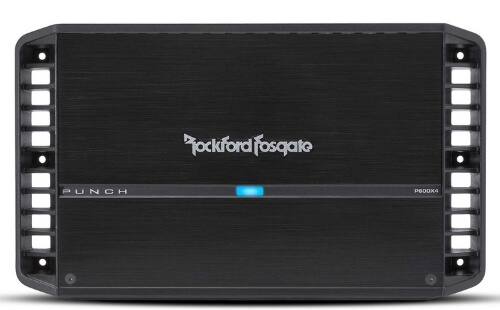
With this 4-channel amp, Rockford is maintaining its image for producing some quality, powerful car audio equipment. The brand has even gone the extra mile, making a product that can work with a much wider range of other hardware than most of the car amplifiers on my list.
Specifically, the Rockford can accept input from far more sources than most amps with an input sensitivity that ranges from 150 mV all the way up to 12 volts. This is generally about 50 mV lower and 2 volts higher than the next closest competitor. If for some reason you have an 8-track, this is the amplifier for you.
This A/B class amp also produces a high-quality soundscape and you’ll go a long way to beat it for sound quality. First, the S/N ratio on this amp is above average with a 150/85 dB, depending on your setup, though, 85 dB is more accurate for most modern standards.
If you are running powerful 2 ohm speakers, this amp will push 150 watts RMS through each channel, whereas 4 ohms will give you 75W per channel. However, the amplifier is bridgeable so you can get more power through your bridged channels if you need.
The RCA inputs can accept both Hi and Low level audio signals without the need of a signal converter, giving you more flexibility with your set up. And with Rockford’s CLEAN set up and variable 12 dB/Oct Butterworth crossovers the amplifier ensures the signal sent to your drivers is crystal clear.
Anyone who likes bass, and who doesn’t, will enjoy the Punch EQ feature with +18dB boost @ 45Hz, which offers some extreme bass if you have the right subwoofer.
All in all, this a high quality amplifier, and will improve any car audio stereo. the only thing is it’s a bit pricey and if you’re packing out a smaller vehicle, this amp might be a bit bulky for you.
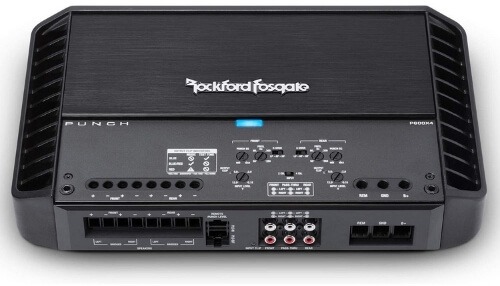
- Easy setup
- Has one of the highest S/N ratios at 105/85 CEA dB
- Bridgeable
- Expensive
- Bulky
Planet Audio Anarchy AC1200.4 – 4 Channel Car Amplifier Under $100
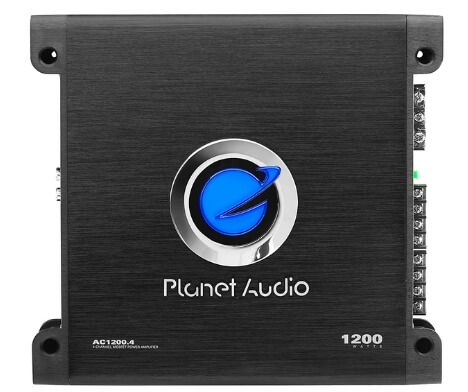
If you want a 4-channel amp for under $100, but still want to make an impact then this Planet Audio Anarchy amplifier will do the trick and more.
This Class A/B flexible 2 Ohm to 4 Ohm 4-Channel bridgeable amplifier will power your car stereo system producing impressive and clear volume for the cheapest price on my list.
The amp benefits from the MOSFET power supply, which helps on power efficiency, and running all four channels at 4-ohms you’ll push 113W RMS per channel. The amp is also stable at 2-ohms, which will give you an impressive 225W RMS per channel.
As already stated, the amplifier is bridgeable, and depending on your configuration, you’ll be able to push some unbelievable power out. For example, bridging it to a 2-channel amp @ 4-ohms will give you a car shaking 450W RMS. Say what!
With something so cheap, you might expect to have less control over the music, but Planet Audio is well-known for giving value for money.
You can easily customize the sound with Variable Low Pass Crossover, Fixed High Pass Crossover and Bass Boost, all of which give you easy control over the sound you desire.
The Frequency Response is standard at 20-20k HZ, but the S/N Ratio is a mesmerizing 102 dB ensuring you get crisp full range at a high volume.
At this price, however, there has to be drawbacks, and this Anarchy series amp lacks in the power terminals and fittings, which aren’t the highest of quality.
The A/B set up does mean it can get a little hot, but thanks to the heavy duty black anodized heatsink, which is needed with this amp, it helps fight the heat.
It is known to get a little too hot in hotter climates, however, so depending on where you live, you might want to take this into consideration.
For this price, however, you’re getting the best 4-channel amp for under $100, and it will definitely improve your car stereo system, and of course make your car stand out and shake.

- 450W RMS is extreme
- Very cheap
- S/N Ratio 102 dB
- Gets hot all too easy
JL Audio JD400/4 – Best 4-Channel Amp For Clear Mids and Highs
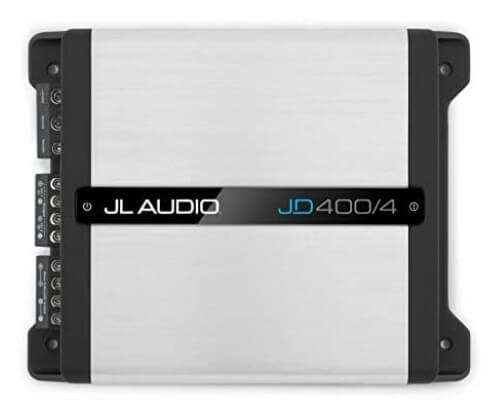
JL Audio is a respected brand in the car audio industry, and has produce some good quality amplifiers over the years. And this JD400 4-channel car amp is another product that maintains the brand’s recognition with my only choice to have preamp outputs.
Only released in 2020, this Class D amplifier boasts a 4 volt preamp output, and will allow you to run the signal from the JL Audio for your 4-channel 6×9 setup into a second amp for a subwoofer.
The amplifier allows for 75 watts RMS @ 4 ohms or 100 watts RMS @ 2 ohms. It’s also fully bridgeable, which will give you much more power and flexibility to push an incredible 200W to 2 channels into 4 ohms.
It’s not just powerful either, this amplifier produces some crystal clear signals thanks to JL Audio’s exclusive NexD™ high-speed switching technologies. This allows the amp to deliver loads of clean power, with excellent efficiency and low distortion.
Signal processing features include high or low-pass 12 dB / octave filters with continuously variable frequency selection from 50-500 Hz for extra clarity. And if that;’s not enough, the amp gives you more flexibility with the differential-balanced inputs that can accept line-level or speaker-level signals.
Not won over yet? If clarity is your thing, the Signal-to-Noise Ratio of this compact amplifier is an incredible 104 dB, while the THD is less than 1% at 2-ohms per channel.
This amp is fantastic and thanks to its bridgeability it gives you many set up options. It’s not the cheapest car amp on my list, but it’s far from the most expensive. If you want something that takes up little space and drives a clear signal efficiently, you will like this JL Audio amplifier.
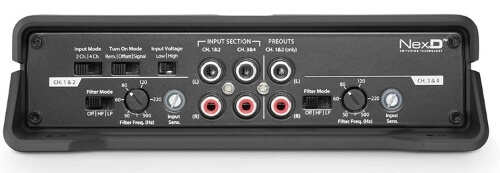
- Nice and compact
- Crisp and clear reproduction
- Bridgeable
- No internal fusing
Kicker CXA300.4 – Best 4-Channel Car Amplifier For Car Door Speakers
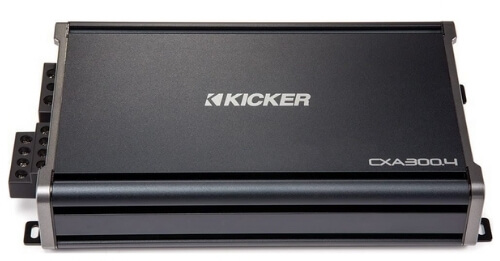
The next product on my list is the Kicker CXA300.4 bridgeable amplifier. It’s not the most powerful on my list, so its best use case is for door speakers, paired with a subwoofer amplifier if you’re going the full monty.
This Class AB amplifier delivers as much as 75 watts RMS per channel @ 4 Ohms if you’re driving all 4 channels, or 150W RMS at 2 Ohms, or 4 Ohms bridged into 2 channels.
The amp’s S/N ratio of 95 dB is actually pretty good – surprisingly good at this price point. And with an input sensitivity range of 125 mV to 10 V, it will drive power efficiently to the right parts.
The amp utilizes Kicker’s trademark bass boost KickEQ™, which gives you as much as a 12dB extra bump giving you some powerful bass when you want it most. And with a powerful 12dB crossover is included, it will quickly tune your system to your liking.
At 109-20k Hz the Frequency Response is wider than most amplifiers on my list. And with high and low level inputs, it’s a great amplifier to pair with a factory head unit.
Unfortunately, this Kicker is one of the larger amps on my list, so if space is tight, it might be better to look elsewhere. That said, the amp uses Kicker’s efficient heat sinks will keep it cool even if space is tight.
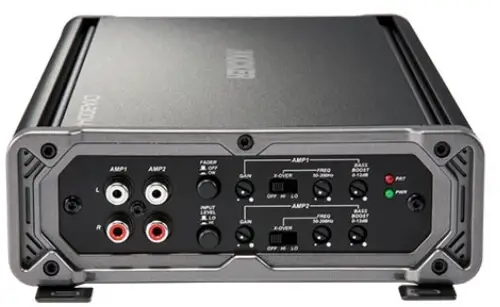
- Bridgeable
- Good S/N ratio of 95 dB
- RMS isn’t the most powerful, but still makes a big difference
- Bulky
Kenwood KAC-M3004 – Best Marine Amplifier
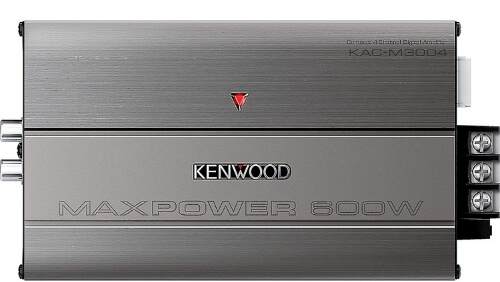
Kenwood is another legacy brand on my 4-channel amp review list that’s been producing top quality car audio equipment for decades.
Some say, in recent years the company has lost some of its lustre, but for me it still manages to find niches in the market where it shines. Case in point, this is the best 4-channel amplifier, whether you want it for an automobile, marine life, AVT or motorcycle.
Whatever your needs, this amp has a very compact size to fit in pretty much any snug corner of your automobile, and any storage compartment on a boat, motorcycle.
The amp benefits from the use a conformal coated main pcb (printed circuit boards) which offers extra layers of protection to fight against moisture or damp air, hence the ideal amp that will come into contact with natural elements more often than not.
It’s a Class D amplifier, so is very efficient on power usage, and the RMS continuous power outage might seem a low at 50×4 @ 4 ohms, and 75×4 at 2 ohms, but the amp is bridgeable, and will power 150W at 4 ohms on 2 channels. This will make a huge impact for anyone wanting some loud and clear volume.
The amp accepts a signal from pretty much any source, whether you’re using RCA cables from an aftermarket receiver or speaker wires from a factory radio, making installation foolproof.
The amp boasts switchable, adjustable crossovers, giving you more control to sculpt the sound you desire, but if there’s one thing that lets it down is the S/N ratio is a low 76 dB. That said, if you’re in a high powered vehicle, like a boat or a motorcycle, you won’t notice.
All in all, this isn’t the most powerful or even best 4-channel amplifier on my list, but it makes an impact in any vehicle at a reasonable price. And if you’re into off-road sports, it should be your first choice.
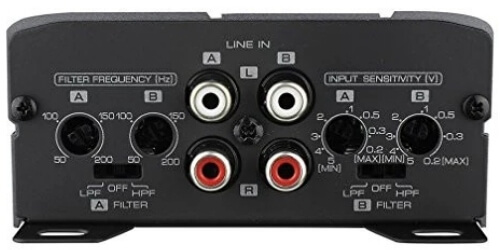
- Easy to wire up
- Compact
- Ideal for Marine life, motorcycles, ATVs etc.
- Not the most powerful
- Low Signal to Noise Ratio
MTX Audio THUNDER 75.4 – Ideal With Dual Subwoofer Output
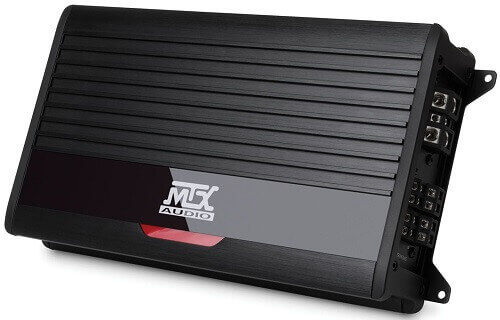
MTX is steadily making a name for itself in the car audio world. The American based audio manufacturer has been putting out high quality equipment for three decades now, and this Thunder 75.4 4-channel amplifier maintains its brand recognition.
The Thunder line of amplifiers has been around for over twenty years, and the evolution of these beasts, keeps MTX Audio at the top table when it comes to powering some serious volume.
This A/B Class amp boasts an incredible 175W @ 4-ohms if you bridge to 2 channels, which will be more than enough for the MTX Terminator Dual 12-inch Subwoofers. And let me emphasize that point: this little beast can easily power your dual subs, no matter what size you have.
If you want a broad spectrum of mids/highs & lows, then you can run all four channels with a pair of 6.5″ speakers and 2 x 6x9s. You can push either 75W RMS x4 @ 4-ohms, or if you want that bit more power you can push 100W RMS into each speaker.
This 4-channel amp produces one of the best soundscapes with a wide frequency range of 15 – 25 kHz – about 5 Hz lower and higher than average.
Its power capability and wiring versatility makes it a perfect choice for running multi-channel speaker systems without compromising musical output or quality, and it can be installed in pretty much any vehicle due to its small chassis size.
The crossover is pretty much expected at this price point: variable LPF 50Hz to 750Hz (Rear), Variable HPF 10Hz-200Hz (Front), Variable HPF 50Hz-750Hz (Rear), 12dB/Oct, but it’s good to know MTX isn’t cutting out on controls after giving so much power for the money.
The S/N Ration is a bit standard at 80 dB, but it’s not too shabby, but with the Total Harmonic Distortion under 1%, you really are getting a powerful and energetic amplifier.
The only thing that lets this four channel amp down is its prone to heating up quite quickly. This is expected with an A/B Class amp, so if you want something that will be a tight fit, it might not be the best choice for you
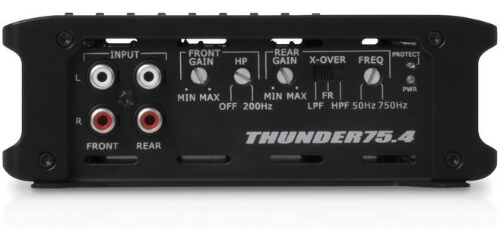
- Very powerful
- Excellent THD
- Wide frequency range of 15 Hz to 25 kHz is great
- Produces more heat than most of the amps
Alpine MRV-F300 – Compact 4-Channel Amp For Any Size Vehicle
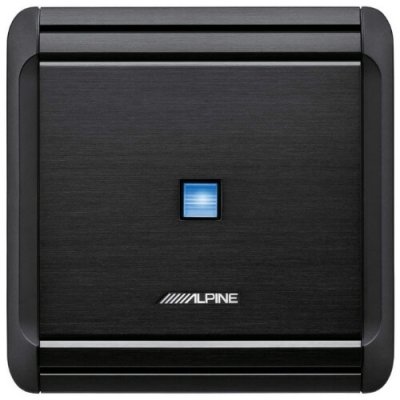
The second Alpine amp on the review is this MRV 300. The compact Alpine V power amps have a 40% smaller footprint than their predecessors, so they can fit in most cars, and even under or behind seats.
But don’t think because they’re smaller, the company has given up on power, because Alpine is streets ahead of most of their car audio rivals when it comes to innovation. Let it be said all Alpine V car amplifiers are powerful and pack a punch.
With a crossover frequency range of 50 to 400 Hz, more of the lower sounds will be directed to your woofer or subwoofer than with most of the other amps on my list, but the power of any partnering subwoofer should be no more 100W.
That said, the Bass EQ function and LPF gives you more control over the bass and allows the woofers to perform the frequencies they’re made to.
The Alpine amplifier features an impressive THD that can get as low as 0.03 percent, depending on your configuration, though running a 4 channel configuration will bump that up to the more standard 1 percent.
With MOSFET power supply and Class D circuitry makes the amplifier more efficient, while the Thermal Management Processor allows this 4-channel amp never gets too hot. This allows you pound your music for a long time with no distortion and best of all no interruptions.
The sound quality is what you’d expect from an Alpine amp, and paired with some high-performance speakers and a subwoofer, this 4-channel amplifier will produce bright and crisp highs, and the bass will be impactful to say the least.
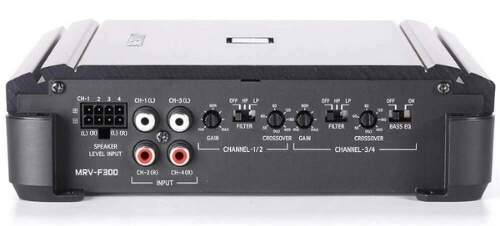
- Nice and compact
- Largest crossover range on my list at 50 to 400 Hz
- Excellent THD from 1% down to 0.03% depending on configuration
- An S/N ratio of 98/81 CEA dB is a bit standard
- Slightly pricey
Memphis Audio SE1200.4 – Powerful 4-Channel Car Amplifier
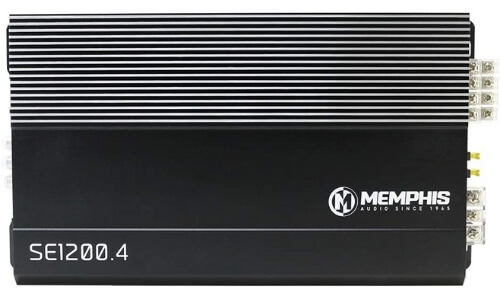
Memphis Audio has built a 50 year legacy in the audio industry by continuously producing some high quality products at a very reasonable price.
And this amplifier is as powerful as one might expect from a high-quality Memphis Audio amplifier. If you run all four channels at 4 ohms you can push 50W per channel. The amp is stable at 2-ohms, so if you require more power you can push 75W per channel.
Not the most powerful on my list, but powerful enough. If you want to bridge the amp you’ll have more possibility with your car stereo set up, and making it into a 2-channel car amplifier at 4-ohms will give you 150W RMS x 2.
For anyone looking for a full-range sound with spellbinding clarity at high volumes, this amp benefits from all the mod-cons you’d expect from a quality amplifier, including High Pass and Low Pass Filters, which ensure there’s no distortion as your music flips from highs to lows.
The THD is <0.1% while the S/N is decent at 85 dB and the 20 Hz – 20k Hz Frequency Response is also standard, but for the money you really shouldn’t expect everything.
Other benefits include Variable Crossovers, 0 – 12dB Bass Boost at 45Hz, and an Infrasonic Filter, all of which makes for distortionless and loud soundscape.
The amplifier is known to get hot, so the Extruded Aluminum Heatsink is a necessity, and the terminals and fittings aren’t the highest standard, but spending a few extra dollars will overcome that problem.
This amplifier isn’t going to win any prizes, but for the price, you’re getting great value for money, and for the price you can really push it to its limits without caring too much.
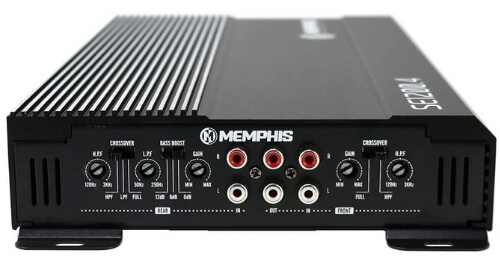
- THD <1%
- Very reasonable under $150
- Bridgeable
- Prone to getting hot
DS18 Select S-1500.4D/RD – Full Range 4 Channel Amp
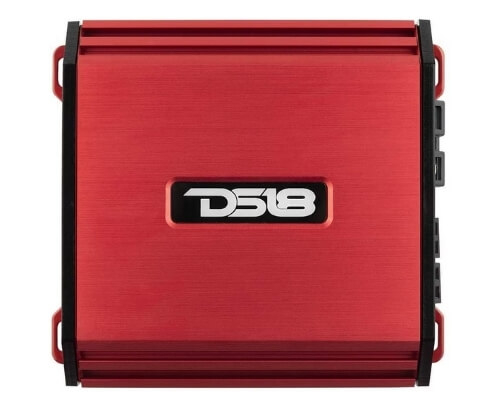
DS18 is the new kid on the block in the car audio industry, but the Miami-based firm is quickly making a name for itself thanks to the durable and powerful equipment it regularly produces at a reasonable price.
And this DS18 S-1500.4D/RD 4 Channel amplifier maintains the brand’s growing status. DS18’s Select series are not only aesthetically pleasing, but new on the market in 2021, this brushed red or silver amp is arguably the most powerful amp for your money.
The Class D amplifier has a variety of settings all of which give you different levels of power and a spectrum of musical options depending on your needs.
At 4-ohms these will push 90W RMS x 4 into each channel, but if you run it at 2-ohms you’ll be able to power 4 channels at an impressive 130W RMS per channel.
This full range allows you to run the most powerful component midranges, tweeters, drivers, or coaxial giving you multiple options for sculpting the sound you want without working this little beast too hard.
The 4 channel amp is bridgeable, however, and if you run it as a 2-channel amp at 4-ohms it will allow you to push a mesmerising 235W RMS into both channels. This will allow you to run some incredibly powerful set of dual subwoofers.
The amp boasts adjustable crossover settings, gain control, and hi/lo pass filters, RCA input/output, all as you might expect, but still good to know you have the control over your sound.
The amp also boasts Short Circuit, Thermal And Voltage Protection just in case the powerful amplifier heats up, which thanks to its Class D efficiency and state of the art circuitry, isn’t often.
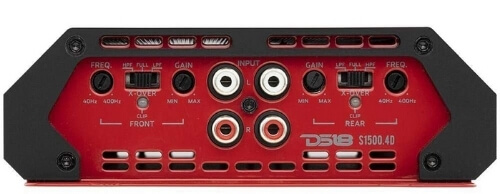
- Very powerful
- Exquisite full range
- Not much to dislike for the price entry
Infographic

Buyer’s Guide
What Is A 4-Channel Amp?
A 4-channel amp is a device that receives an electrical signal and, as the name implies, amplifies that signal. It then sends that signal along its channels to be received by speakers, whether loudspeakers, dedicated tweeters, or subwoofers. As the name suggests 4 channel amplifier puts out equal power to all 4 channels.
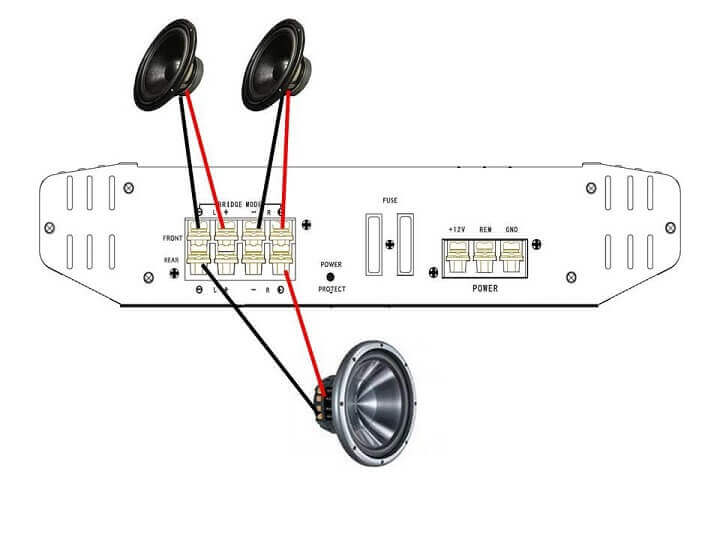
However, some 4 channels amps have the ability to combine the power from multiple channels via a process called bridging. This will often double the amp’s output, but this is not always the case, especially among lower quality amps.
4 Channel Amp vs 2 Channel Amp
A 4-channel amp is generally used to power either 4 speakers–often 6x9s + front speakers, or 2 front speakers and a subwoofer with 2 channels bridged.
Of course, if you want to power all four speakers as well as the subwoofer then you’ll either need to get a 5-channel amp or, more likely, purchase a monoblock, which is separate amp for the subwoofer.
When bridging, you can wire the speakers in parallel, but the resistance of the speakers might decrease so you need to pay attention to amplifier impedance ratio.
Granted, it is entirely possible to power 2 standard 6×9 speakers with a 2-channel amp, but 2 channel amps are not really designed for this purpose.
Instead of simply powering two standard speakers, a 2-channel amp is often be used to power one or two subwoofers instead.
It should be noted, a 2-channel amp will generally put out more RMS wattage through each of its channels than a 4-channel. This additional power serves the 2-channel amp’s true purpose: to push the bass.
Keep in mind, it is not altogether uncommon for an amp set up with both a 4-channel amp and a 2 channel amp. The former will power the speakers, while the latter powers the subwoofer or subwoofers. And in this case, your car audio speakers will have some amazing power.
Watts Per Channel and Impedance
These two wattage values will determine the power that your amp can push to the speaker system. However, Peak Power is generally used as a marketing ploy with RMS being the more important of the two.
RMS wattage relates to the power that can be pushed at a constant rate through each channel, while peak wattage refers more to the maximum wattage the amp can push in a single burst.
For RMS wattage, there will often be two or more different values depending on the impedance of the speaker. Generally, the higher the impedance, the lower the RMS wattage per channel. However, there are a few amps that push the same amount of wattage per channel, no matter the impedance.
While impedance is not necessarily a quality concerning the amp exclusively, it is still one of the more important aspects of your speaker system for producing the best audio quality.
Your speakers will have their own impedance rating, and whatever it is, the amp needs to be able to push power through its channels at that ohm level. You can’t hook up fewer speaker impedance than amplifier impedance.
For example:
Amp – min 4 ohm to channel
Speakers – 2 ohm (can’t)
Speakers – 8 ohm (ok, but requires more power)
Look For How Big The Amp’s Fuse Is
The size of the amp’s fuse will determine whether or not the amp can actually produce the continuous wattage it advertises. The formula for this is to multiple the watts by 2 then divide by the car battery.
For example, if an amp puts out 250 watts, you first multiple that by 2 – the numbers of watts coming in. Then you divide that by the car battery’s voltage, usually 14.4 volts. This gives you 35 amperage. If the amplifier does not use fuses with at least a 35 amperage rating, the amplifier will not be able to constantly push all 250 watts.
Compatibility Of Head Unit With Amplifier
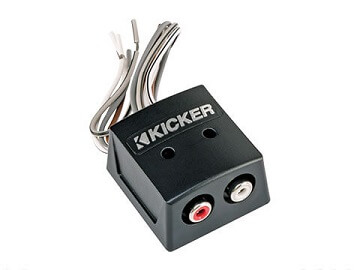
In terms of input plugs, most factory head units don’t have preamp outputs (RCA). If the amp can receive a speaker level signal, the receiver does not matter.
However, if the amp can only receive a preamp signal, then the head unit will need to add a line output converter (LOC).
The LOC then converts a speaker-level output signal into an RCA preamp-level signal. This lets you connect the stereo to the amplifier, and it can also be used to connect a new stereo to a car’s factory amp.
Amp Class
This refers to the “topology” of the amplifier’s architecture. While there are technically 4 types of amplifier topology, you will most commonly run across two within automotive audio systems: AB and D class.
AB Class has a tendency to produce better sound quality. However, even many audiophiles will acknowledge the difference is generally negligible if you can even pick it out. This topology also produces far more heat than the D Class.
For a D Class topology, the high frequency reproduction is technically inferior, although the registers are usually beyond a point of meaningful distinction. The D Class is much more energy efficient and produces less heat than the AB Class.
The difference between the AB and D Class high frequency registers may have been more pronounced at one time, but it is generally accepted as a minimal difference in modern amps. However, energy consumption and heat output remain a big difference.
Sound Quality
There are a few features and factors that will ultimately impact the best sound quality your amp can provide. Some of these include filters, frequency response, sensitivity, sound-to-noise ratio, and total harmonic distortion (THD).
All of these affect different qualities of the soundscape, and depending on what you’re listening to, some will be more important than others.
Filters – There are 3 filters used, two of which are found on most decent amps and one that is a bit specialized. The two filters found on most amps will be high pass and low pass.
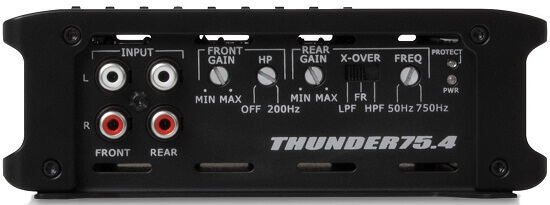
If a signal isn’t high pitched, running along a lower but still medium level range, the low pass filter (LPF) will only send that signal to channels running speakers which will play that frequency – usually the midbass or subwoofer.
Conversely, a high pass fade (HPF) will filter out the higher frequency signals and only send them to speakers designed to play the higher frequency registers–usually the tweeters and super tweeters.
Frequency Response – This quality determines the maximum range of frequency signals the amp can push. The higher the number, the broader the soundscape. However, frequency response can be a bit misleading as many of the highest and lowest frequencies are inaudible to the human ear, which ranges from 20Hz to 20kHz.
Once a frequency is too low, it enters the subharmonic stage, though these frequencies can often still be felt, just not heard. Likewise, once a frequency gets too high, it enters the superharmonic phase, but these frequencies are generally not only inaudible but can’t be felt either.
THD – Total Harmonic Distortion determines how accurately the amp replicates the input signal as it pushes it through to the speakers. The lower this value the better.
Essentially, as the signal reaches the amp and is decoded to then be pushed at a higher power to the speakers, the signal can become modulated and distorted.
Better amps will have the lowest THD and more accurately reproduce the signal at higher power values. Beware of amps with a THD above 3 percent as you will start to notice the difference in sound quality, and the actual sounds will be different than on a better system.
Sound-to-Noise Ratio or S/N, is a value that determines how much “noise” or interference the signal carries through the amp and is measured in decibels. The higher this number the better.
Size
Older amps were often large, heavy slabs that generated a great deal of heat and needed a lot of open room to disperse that heat. As technology advances, companies have started producing more compact amps that can fit in smaller and smaller places.
However, that doesn’t prevent the amp from still generating a considerable amount of heat. As such, the size of the amp will limit and determine where you can place it. Smaller amps can often be placed under a seat and still have access to enough airflow to remain at equilibrium.
Getting The Best 4-Channel Amp For You
The best 4-Channel amps on the market is always up for debate, and there’s no science that points to one. If you have the disposable income, however, there really is nowhere else to go except the Alpine X-A70F.
But of course, it is very expensive, and if you can’t stretch the budget that far, the other amps in each niche are worth paying attention to.
If you want something that’s great value all around, the Kicker CXA300.4 is a great amp that has a wide range of versatility to suit more configurations than most.
If you intend to run an amp for your speakers and an amp for your subwoofer – something I highly recommend – then the JL Audio JD400/4 is where you should look. Of course, if you just want one amp to rule them all without breaking the bank, you can’t go wrong with the Alpine MRV-F300.
Regardless, there’s an amp that can fit your needs on the list no matter what you’re looking for. And with the help of my comprehensive buyer’s guide, you should now be able to make a more informed choice for your next upgrade.
Whichever 4-channel you get, and for whatever reason, I’m sure it will enhance your every drive. Have fun.

I am a passionate and skilled car audio enthusiast with 15 years of experience in the industry. My journey started when I replaced my first set of factory car speakers, sparking a deep love for high-quality sound. Since then, I have worked as a representative for renowned brands like Kenwood and Alpine.
With a background in both retail and distribution, I have developed a comprehensive understanding of the car audio market. Currently a certified (MECP) installer in the Mobile Electronics industry, my expertise lies in delivering top-notch audio installations. My knowledge, coupled with my genuine passion, makes me the go-to professional for all car audio needs.


Hi Andrew!
How many rca cables for 4 channel amp needed? Thanks advance.
Hi Emily,
You’ll need 2 pair stereo RCA cables.
If you have only 1 pair RCA output on the back of your head unit:
– You can connect single RCA cable to the back of your head unit and at the other end use 2 Y-splitters but fade will don’t work.
Hey, I’m looking to upgrade my 2011 f150 supercrew speakers. I’ve been reading and reading and reading about every speaker I can and Amps and their rms ratings, db ratings and basically every bit of info I can. And I’m still lost with all this. At the end of the day, I want (4) 6×8 coaxial speakers, 2way or 3way, powered properly with an amp, that are gonna be good at producing bass, mids and highs, without braking my bank account. I don’t want a sub in my truck so I want these speakers to have some boom, but also be clear. I have an aftermarket dual brand head unit, it’s not amazing but it came with Apple car play and has a lot more options then expected. Can you suggest some speakers and amps that would fit what I’m looking for?
That would be super appreciated
Hi Darcy,
It depends what type of music you listen to. But if you want low bass you need a sub. Speakers can produce only midbass and highs.
Most of the name brand speakers will be fine (Kicker, Focal, Morel, Rockford, Alpine R-series, Pioneer Pro-series and so on).
I would suggest buying an adapter to fit a 6.5 speakers. You’ll have a much bigger selection, sound better and much better prices. Read my 6.5 speakers review here https://soundrating.com/best-6-5-speakers/ and here https://soundrating.com/best-6-5-component-speakers/
Match your rms of the amp to the rms of some speakers you want.
There are door speakers that go down to 30 hz. That is lower than some Cerwin vega home speakers with 15″ woofers.
Hey just trying to decide what kind of amp to get for my car. I’m going to be installing 4 x 6.5 4 ohm speakers @ 70 watt rms each and 1 subwoofer 200watt rms 4 ohm
I will be running single set of RCA with y splitters to amp. Just seeing if I have any options for 1 amp or do I need 2 different ones?
Hi Ernie!
They produce 5 channel amps specifically for one sub, 2 rear, and 2 front speakers…
Can I run 4 speakers from my 4 channel amp and then another 2 off head unit power only?
Hi Timothy,
Yes, you can. They just won’t be as loud as the ones that are amplified.
If your amp can go down to 2 ohms you could wire 2 speakers to a channel.
What is the ideal amplifier for 1300W bass tube and 2 x 500W speakers all connected simultaneously? Bass Tube: JBL GT-X1300T Speakers: JBL A500HI, All have impedance of 4 ohm. I’m currently using Jbl A6004 but have got repaired twice.
Need help!
I like this Alpine 4-Channel amp. It’s expensive, but it will do the trick and you’ll be impressed. And all the repairs are costing you, so a one-off big payment might end up being a saving.